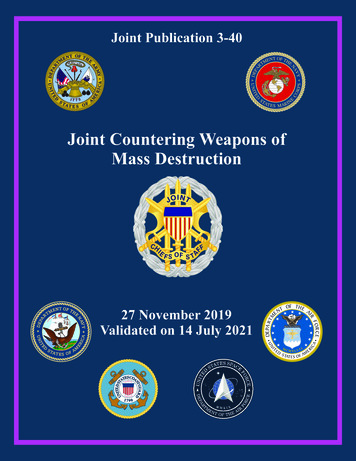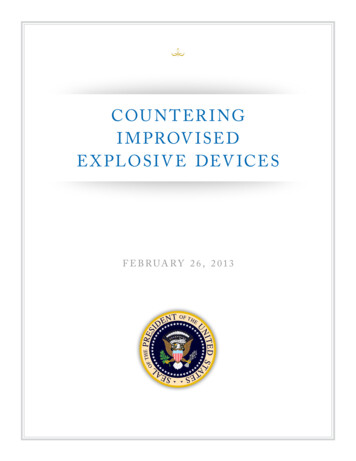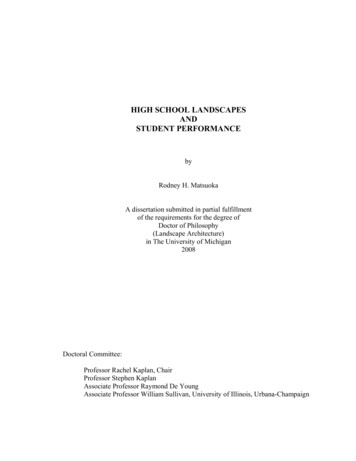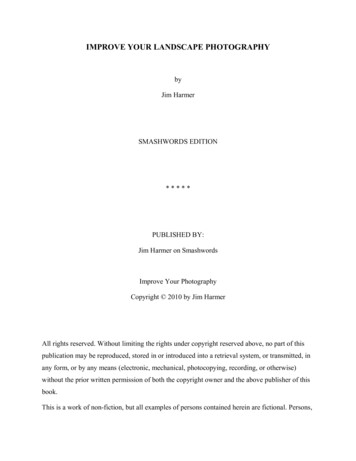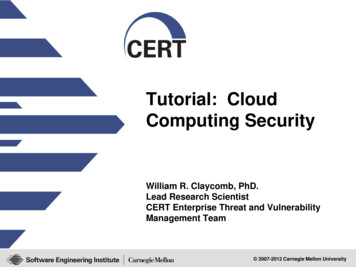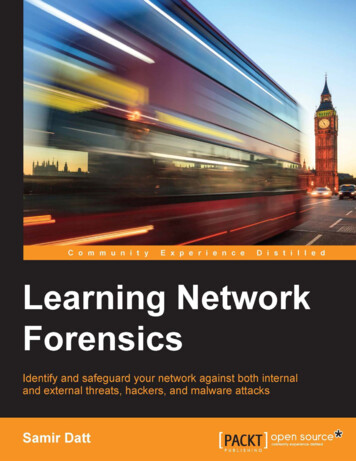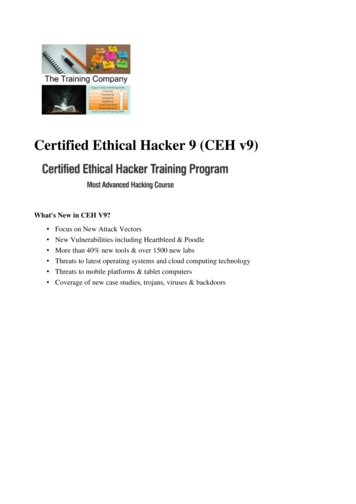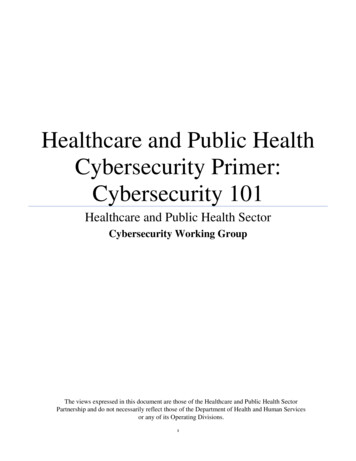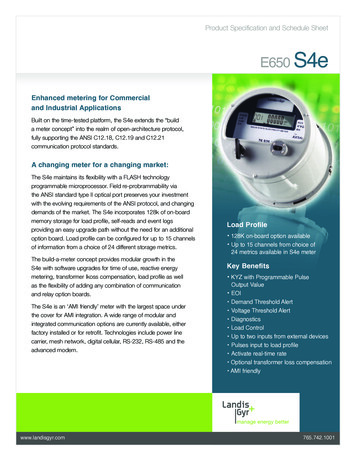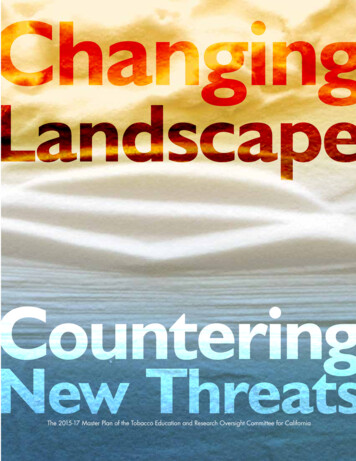
Transcription
ChangingLandscapeCounteringNew ThreatsThe 2015-17 Master Plan of the Tobacco Education and Research Oversight Committee for California
Changing LandscapeCountering New ThreatsToward a Tobacco-Free California, 2015-2017Master Plan of theTobacco Education and Research Oversight CommitteeJanuary 2015Available on the Internet at: cdph.ca.gov/services/boards/teroc
Suggested Citation:Tobacco Education and Research Oversight Committee. Changing Landscape: Countering New Threats,2015-2017. Toward a Tobacco-Free California Master Plan. Sacramento, CA: Tobacco Education andResearch Oversight Committee. 2014.
ContentsThe Threats to a Tobacco-Free California . 1Letter from the Chair. 3Proposition 99. 5About the Tobacco Education and Research Oversight Committee. 5Members of the Tobacco Education and Research Oversight Committee. 7Mission, Vision, and Goal of Tobacco Control in California . 9Principles for Tobacco Control in California . 11Acknowledgments. 13Executive Summary . 15Tobacco-Free California 2015-2017 Master Plan Summary. 17Changing Landscape: Countering New Threats . 19Objectives and Strategies for 2015-2017. 27OBJECTIVE 1: Raise the Tobacco Tax . 27OBJECTIVE 2: Vigorously Protect and EnhanceTobacco Control Capacity in California . 33OBJECTIVE 3: Achieve Tobacco-Related Health EquityAmong California’s Diverse Populations . 39OBJECTIVE 4: Minimize the Health Impact of Tobacco Use onPeople and the Environment . 51OBJECTIVE 5: Prevent Youth and Young Adults from Beginning to Use Tobacco. 59OBJECTIVE 6: Increase the Number of Californians Who Quit Using Tobacco. 69OBJECTIVE 7: Minimize Tobacco Industry Influence and Activities. 75Appendix A: Achievements from Master Plan 2012-2014. 89Appendix B: Summary of TEROC Policy Statements in the 2015-2017 Master Plan. 99Appendix C: Additional Data and Charts. 113Endnotes . 115
The Threats to a Tobacco-Free California Insufficient tobacco excise taxes to effectively discourage tobacco use initiation by youth andcontinued use by all tobacco users Insufficient funding to maintain a comprehensive tobacco control program Failure to comprehensively regulate sales, marketing, and distribution of tobacco-related products,including electronic cigarettes (e-cigarettes) Legislative and regulatory exceptions which fail to equally protect all people and communities fromexposure to secondhand and thirdhand smoke Magnitude of spending by the tobacco industry and its related interest groups to undermine California’ssuccess decreasing smoking prevalence, saving lives, reducing costs, and changing social normsChanging Landscapes: Countering New Threats1
Letter from the ChairCalifornia has been synonymous with tobacco control success – the palpable difference in the air whentraveling to another state or country is a constant reminder of what California has achieved. The keystoneto this success has been the tobacco control efforts and programs supported by the Tobacco Tax andHealth Protection Act of 1988. With over one million lives saved from tobacco–related diseases and over 134 billion in healthcare costs avoided, the benefits speak for themselves.Although California has much to be proud of, we now face a changing landscape. California will need toeffectively counter new threats if we are to continue the progress we have made since 1988. The proliferation of new products, such as electronic cigarettes (e-cigarettes), potentially threatens all of California’shard won successes by rendering California tobacco regulations obsolete. The consolidation of the secondand third largest tobacco companies will only increase the market power of an industry that alreadyoutspends California tobacco control by 15 to 1. As we enter a new age in healthcare with the advent ofthe Patient Protection and Affordable Care Act, reducing tobacco use and preventing tobacco use initiationwill be even more critical in order to reign in rising healthcare costs. Despite our overall strides in reducingtobacco use, some populations in California continue to have high tobacco use.Addressing these new challenges requires a much greater level of commitment and action by all inCalifornia if we hope to maintain our achievements in health and prosperity attained through tobaccocontrol. The resources provided by the Tobacco Tax and Health Promotion Protection Act of 1988 by itselfwill not be sufficient for California to succeed in the face of these challenges.This Master Plan by the State of California Tobacco Education and Research Oversight Committee providesa blueprint of objectives and strategies that, if met, will ensure that our communities, friends, families, andloved ones will be able to avoid the health and societal costs from direct tobacco use and subsequenteffects from secondhand smoke exposure and environmental degradation.Even in chaos there are opportunities. Bold action is needed. California’s future depends on all of us.Michael Ong, M.D., Ph.D., ChairJanuary 2015Changing Landscapes: Countering New Threats3
Proposition 99In November 1988, California voters passed ballot initiative Proposition 99 (the Tobacco Tax and HealthProtection Act of 1988), which added a 0.25 excise tax per cigarette package and a proportional taxincrease on other tobacco products beginning January 1, 1989. Proposition 99 declared the state’s intent:“To reduce the incidence of cancer, heart, and lung disease and to reduce the economic costs of tobaccouse in California, it is the intent of the people of California to increase the state tax on cigarettes andtobacco products.” A portion of the tax was designated for public health programs to: Prevent and reduce tobacco use Provide healthcare services Support tobacco-related research Protect environmental resourcesThe California Tobacco Control Program (CTCP) was established in 1989. Twenty years later, the historyof its development and its many accomplishments were celebrated in a special 2010 supplement of thejournal Tobacco Control, entitled The Quarter that Changed the World.About the Tobacco Educationand Research Oversight CommitteeThe Tobacco Education and Research Oversight Committee (TEROC) was established by the enablinglegislation for Proposition 99 (California Health and Safety Code Sections 104365-104370) which mandatesTEROC to: Prepare a comprehensive Master Plan toguide California tobacco control efforts,tobacco use prevention education, andtobacco-related disease research; Advise the California Department of PublicHealth (CDPH), the California Departmentof Education (CDE), and the University ofCalifornia (UC) regarding the administrationof Proposition 99 funded programs; Monitor the use of Proposition 99 tobaccotax revenues for tobacco control programs,prevention education, and tobacco-relatedresearch; and Provide programmatic and budgetaryreports on Proposition 99 tobacco controlefforts to the California Legislature withrecommendations for any necessary policychanges or improvements.Pursuant to the Bagley-Keene Open Meeting Act, all TEROC meetings are open to the public. More information about TEROC, including meeting announcements, meeting minutes, press releases, and previousMaster Plans can be accessed online at www.cdph.ca.gov/services/boards/teroc.Changing Landscapes: Countering New Threats5
Members of the Tobacco Educationand Research Oversight CommitteeTEROC is comprised of 13 members. Pursuant to California Health and Safety Code Section 104365, theGovernor appoints eight members (one of which is a pending appointment), the Speaker of the Assemblyappoints two, the Senate Rules Committee appoints two, and the Superintendent of Public Instructionappoints one member. Current TEROC members are:Michael K. Ong, M.D., Ph.D., ChairAssociate Professor in ResidenceDepartment of MedicineUniversity of California, Los AngelesDenise Adams-Simms, M.P.H.Executive DirectorSan Diego Black Health AssociatesLourdes Baézconde-Garbanati, Ph.D., M.P.H., M.A.Associate Professor in PreventiveMedicine and SociologyInstitute for Health Promotion andDisease Prevention ResearchKeck School of MedicineUniversity of Southern CaliforniaVicki BaumanPrevention Director IIStanislaus County Office of EducationWendel Brunner, Ph.D., M.D., M.P.H.Director of Public HealthContra Costa Health ServicesPatricia Etem, M.P.H.Executive ConsultantCIVIC CommunicationsChanging Landscapes: Countering New ThreatsLawrence W. Green, Dr.P.H., Sc.D. (Hon.)Professor, Department ofEpidemiology and BiostatisticsHelen Diller Family Comprehensive CancerCenter & Center for Tobacco ControlResearch & EducationUniversity of California, San FranciscoAlan Henderson, Dr.P.H., C.H.E.S.Professor EmeritusCalifornia State University, Long BeachPamela Ling, M.D., M.P.H.Associate Professor, Department of MedicineUniversity of California, San FranciscoMyron Dean Quon, Esq.Executive Director, National Asian PacificAmerican Families Against Substance AbuseDorothy Rice, Sc.D. (Hon.)Professor Emeritus, Institute for Health and AgingSchool of NursingUniversity of California, San FranciscoShu-Hong Zhu, Ph.D., M.S.Professor, Department of Familyand Preventive MedicineUniversity of California, San Diego7
Mission, Vision, and Goal ofTobacco Control in California Mission: To eliminate tobacco-related illness, death, and economic burden. Vision: A tobacco-free California. Goal: To reduce the overall tobacco use prevalence (cigarettes, and all other tobacco productsincluding electronic cigarettes [e-cigarettes] and other electronic nicotine delivery systems) to 10percent for adults and 8 percent for high-school age youth by December, 2017.TEROC updated its goal for the 2015-2017 three-year Master Plan cycle in recognition of the evolvingnature of tobacco use in California. The new goal identifies a target for overall tobacco use prevalence byadults and youth rather than the limited goal of cigarette smoking prevalence. Prevalence rates for tobaccoproducts, including other emerging tobacco products such as e-cigarettes, will be tracked and reported.Realizing the vision of a tobacco-free California requires that California aggressively and tirelessly pursuethe Master Plan goal. Resulting benefits to all residents include minimizing the harm caused by tobaccoon the health, quality of life, and environment as well as the avoidable cost burden on the taxpayers andsociety as a whole.Administration ofCalifornia’s Proposition99 Tobacco ControlEffortsCalifornia’s Proposition99 tobacco controlefforts are administeredby three state entitiesthat work togethertoward achieving themission, vision, and goaldefined by TEROC forthe 2015-2017 MasterPlan period.“Full and expeditious implementation of TEROC’s updated three-yearMaster Plan will speed up progress towards a smoke-free California. TEROCrecognizes the potential threat to public health from the rapid emergence ofe-cigarettes and sets out a strategy for tracking and responding to their use.With this Master Plan, which builds on experience gained since the landmark1964 report of the Surgeon General on tobacco and health, California willcontinue as a national leader in evidence-based tobacco control. I urge allwho care about the health of Californians and the nation to take action toimplement policies and legislation that will protect individuals from unnecessary disease, death, and economic costs to help achieve a smoke-freeCalifornia. We know how; do we have the will to succeed?”Jonathan M. Samet, M.D., M.S.Distinguished Professor and Flora L. Thorton Chair,Department of Preventive Medicine,Keck School of Medicine and Director, Institute for Global Health,University of Southern California.The California TobaccoControl Program of theCalifornia Departmentof Public Health (CDPH/CTCP) administers the public health aspects of the program, including current Proposition 99-fundedtobacco control activities of 61 local health departments, 42 community non-profit organizations, eightChanging Landscapes: Countering New Threats9
statewide training and technical assistance and cessation service projects, the statewide media campaign,and an evaluation of the effectiveness of the public health and school-based components. More information is available at www.cdph.ca.gov/programs/Tobacco.The Coordinated School Health and Safety Office of the California Department of Education (CSHSO/CDE) is responsible for administering the Tobacco-Use Prevention Education (TUPE) program in over 961school districts, 58 county offices of education, and more than 600 direct-funded charter schools. Moreinformation is available at www.cde.ca.gov/ls/he/at/tupe.asp.The Tobacco-Related Disease Research Program (TRDRP), administered by the University of California,Office of the President (UCOP), funds research that enhances the understanding of: tobacco use, prevention, and cessation; the social, economic, and policy-related aspects of tobacco use; and tobacco-relateddiseases. More information is available at www.trdrp.org .10Changing Landscapes: Countering New Threats
Principles for Tobacco Control in CaliforniaSince 1988, the people of the State of California, in concert with local health agencies, coalitions, education departments, research, civic and medical institutions, and community-based agencies, have upheldthe public’s commitment to support and implement statewide, tobacco-tax funded programs to preventand reduce tobacco use and tobacco-related diseases.These stakeholders are guided by principles integral to the effectiveness of California’s Master Plan fortobacco control: Build strategic alliances to generate and sustainfunding to maximally support a comprehensive, statewide tobacco control program; Engage communities and populationsdisproportionately impacted by tobaccorelated disease and death to lead effortsto reduce health disparities and achievetobacco-related health equity; Integrate social norm change and population-based approaches and interventions intobacco control program efforts and design; Develop multi-generational and multi-professional tobacco control leadership throughcommunity-based engagement, youth andadult training, internships, fellowships, coalition advocacy, and professional development;Changing Landscapes: Countering New Threats Confront assaults on California’s tobaccocontrol infrastructure and progress byproviding statewide technical assistance,using scientific evidence-based data, andmodeling best practices to: Educate and empowerdecision-makers; Uphold program integrity; and Optimize return on investments,health outcomes, and reach; Use evidence to guide decision-makingin tobacco control efforts, education, andresearch; and Set performance goals for tobacco controlprograms, education, and research toachieve measurably positive outcomes forcommunities and all of California.11
AcknowledgmentsTEROC thanks the many individuals and groups that are committed to tobacco control in California andthat contributed to this Master Plan. Special appreciation is extended to the following: TEROC members who served over thepast three years and contributed to theimplementation of the past Master Plans:Peggy M. Uyeda, Naphtali Offen, KathleenVelazquez, Valerie B. Yerger; Local health departments, tobacco controlcommunity programs, County Offices ofEducation, Local Lead Agencies, LocalEducation Agencies, and schools throughoutCalifornia, without which a comprehensivetobacco control program would not exist; Participants in California tobacco controlefforts that provided input into the development of the 2015-2017 Master Planobjectives and supporting strategies; Advocacy and Data Dissemination toAchieve Equity for Priority Populations onTobacco (ADEPT); Members of the academic communitywhose research findings are contributing to agreater understanding of tobacco control;Changing Landscapes: Countering New Threats April Roeseler, Jonathan Isler, NadineRoh, Colleen Stevens, Richard Kwong,Alexandria Simpson, Mary Modayil, GrettaFoss-Holland, Leslie Ferreira, Patti Seastrom,Francisco Michel, Janette Chin, Mary Strode,Stephanie Louie, Patricia Laija, ValerieQuinn, and other staff of the CaliforniaDepartment of Public Health, CaliforniaTobacco Control Program; Tom Herman, Greg Wolfe, JohnLagomarsino, Margarita Garcia, and otherstaff of the California Department ofEducation, Coordinated School Health andSafety Office; Bart Aoki, Phillip Gardiner, Norval Hickman,Anwer Mujeeb, and other staff of theTobacco-Related Disease Research Program;and Mary Croughan, Executive Directorof the Research Grants Program Office,University of California, Office of thePresident; and Lynn H. Baskett, who facilitated the development and writing of this Master Plan.13
Executive SummaryTEROC presents the 2015-2017 Master Plan for a tobacco-free California in compliance with CaliforniaHealth and Safety Code Sections 104365-104370. All of the objectives and strategies in the Master Planstrengthen the nationally and internationally recognized tobacco control programs built and tested sincevoters approved Proposition 99, the Tobacco Tax and Health Promotion and Protection Act of 1988.Countering the threats to a tobacco-free California requires commitment and the political will to prioritizethe health promotion and protection of Californians. Benefits of policy leadership include increased health,quality of life, and economic vitality as well as decreased costs for individuals, employers, and local, state,and federal governments.California developed the model for comprehensive state tobacco control nationally, which, at its core,denormalizes the use of tobacco products. Will elected leaders, policy makers, and community leaders onall levels be strong enough to complete the task of creating a healthy, tobacco-free California?Reducing the negative health impact of tobacco products and nicotine delivery systems depends onassertive policy actions. TEROC urges elected officials and those with influence to use their positionsfor the greater good of California and support the following key policy recommendations: Update the definition of tobacco to includeall tobacco products and nicotine deliverysystems that are not approved by the Foodand Drug Administration (FDA) for therapeutic uses; Increase the tobacco excise tax by at least 1.00 per pack of cigarettes with an equivalent tax on other tobacco products andspecifically designate at least 20 percent ofthe increase for tobacco control programs,indexed incrementally to inflation; Tax all tobacco products and nicotinedelivery systems that are not approved bythe FDA for therapeutic uses and specificallydesignate at least 20 percent of the increasefor tobacco control programs, indexedincrementally to inflation; Reduce tobacco excise tax evasion. Useproceeds for tobacco control programs;Changing Landscapes: Countering New Threats Use a greater proportion of the Proposition99 Unallocated Account for tobacco controlprograms to further save the State avoidablehealthcare costs; Achieve tobacco-related health equity,including eliminating exemptions inpolicies which allow tobacco-relateddisparities to persist; Eliminate secondhand and thirdhandexposure to smoke and environmentaltoxins by regulating the sales, promotion,marketing, distribution, and use of tobaccoand nicotine delivery system products; Aggressively enforce current and enhancedregulations; Close loopholes in smoke-free workplaceregulations; Combat tobacco industry actions, includingthe marketing of e-cigarettes, flavoredtobacco, and any other products that eitherentice or encourage youth and young adultsto begin using tobacco;15
Require all public and private K-12, college,vocational, and trade schools to betobacco-free; Support initiatives that encourage allhealthcare professionals to use every patientencounter to encourage tobacco cessation; Provide easy access to FDA-approvedcessation medications. Remove barriers toaccessing cessation counseling and medications in all public and private sector healthplans; Promote efforts to diminish tobacco industrycampaign contributions or other financialsupport to elected officials and caucuses; Promote policies and practices thatdenormalize tobacco use and the tobaccoindustry; and Act locally to protect residents fromtobacco- related harms without waiting forstate and federal legislative and regulatoryprocesses.TEROC also supports continuation of support for the scientific efforts needed to reduce tobaccoinitiation and use, and particularly to decrease the social acceptability of tobacco use and the tobaccoindustry. From this research, California has learned and documented what works and where resourcescan be spent with highest impact. A comprehensive research program includes monitoring, surveillance,research, and evaluation: Monitoring the implementation of fundedprograms, services, and strategies providesevidence of problems in the applicationof policies and generates program recommendations that can be addressed withintensified training and technical assistanceto localities and institutions; Surveillance provides evidence of progress,or relative lack of it, on outcomes in specificgeographic and social segments of the state,guiding the tobacco control program on theneed to shift resources; Evaluation provides evidence on specificinnovations in state and local programs thatcan be used to support appropriate policyand program decisions; and Research provides new evidence in emergingareas that can help guide tobacco controlefforts, including those by California and theFDA, as they regulate tobacco products.This Master Plan, Changing Landscape: Countering New Threats, describes the context for tobaccocontrol programs and the emerging threats. Each objective includes specific strategies and evidence-basedresearch to support the strategies. Throughout the Master Plan, TEROC policy statements are in bold italicsand summarized in Appendix B. The Master Plan is also available online atcdph.ca.gov/services/boards/teroc.In its advisory role to the California legislature, TEROC urges leadership on behalf of all Californians,and stands ready to support legislative and regulatory actions to decrease tobacco use of all types andto denormalize tobacco.16Changing Landscapes: Countering New Threats
Tobacco-Free California 2015-2017Master Plan SummaryThe Tobacco Education and Research Oversight Committee (TEROC) presents this 2015-2017 Master Planfor tobacco control in accordance with California Health and Safety Code Sections 104350-104480. Thisdocument provides programmatic recommendations to the State’s three tobacco control agencies: theCalifornia Department of Public Health (CDPH), the California Department of Education (CDE), and theUniversity of California (UC).In addition, the Master Plan informs elected officials, agencies, organizations, groups, educators,researchers, advocates, community leaders, and other concerned citizens about the status of tobaccocontrol in California and critical actions needed to achieve a tobacco-free California.Much has been accomplished, but muchremains to be done. Continued progresstoward a tobacco-free California requiresa renewed commitment from the peopleof California.Use this Master Plan to inform andeducate: Yourself Your family, friends, and neighbors Elected officials Business, professional, youth, andother organizations and leaders The mediaCall to Action“ we must remain committed to decreasing thedeath, disease, and healthcare costs attributed totobacco by supporting tobacco users who want toquit, and protecting young people from the influenceof tobacco product marketing.”1Ron Chapman, M.D., M.P.H.Director and State Health OfficerCalifornia Department of Public Health2015-2017 Master Plan Objectives and StrategiesObjective 1: Raise the Tobacco TaxObjective 2: Vigorously Protect and Enhance Tobacco Control Capacity in CaliforniaObjective 3: Achieve Tobacco-Related Health Equity Among California’s Diverse PopulationsObjective 4: Minimize the Health Impact of Tobacco Use on People and the EnvironmentObjective 5: Prevent Youth and Young Adults from Beginning to Use TobaccoObjective 6: Increase the Number of Californians Who Quit Using TobaccoObjective 7: Minimize Tobacco Industry Influence and ActivitiesChanging Landscapes: Countering New Threats17
Changing Landscape: Countering New ThreatsThe tobacco control environment in California continues to evolve; yet, saving the lives of Californiansremains the goal. Since the last Master Plan (2012-2014), the tobacco marketplace has been transformedby an array of new tobacco products and electronic nicotine delivery systems, commonly called electroniccigarettes (e-cigarettes). With these new products, the tobacco industry and its related interest groups,such as the advertising and entertainment industries, are working harder than ever to sell smoking as notonly acceptable, but also stylish and cool. The hallmark of California’s successful tobacco control programover the past 27 years has been changing the norms related to smoking and empowering non-smokersto confidently demand a healthy environment. Social norm change has been key to California’s historicalleadership role in the country and the world.The strength of California’s tobaccocontrol efforts is being eroded by:In this Master Plan,“tobacco product” means: Insufficient tobacco excise taxes toeffectively discourage tobacco useAny product that contains tobacco, is derived frominitiation by youth and continuedtobacco, or contains synthetically produced nicotine anduse by all tobacco users;is intended for human consumption. “Tobacco Product” Insufficient funding for comprehendoes not include any cessation product specificallysive tobacco control programs;approved by the U.S. Food and Drug Administration Failure to comprehensively regulate(FDA) for use in treating nicotine or tobacco dependence.2sales, marketing, and distribution oftobacco-related products, includingThe Master Plan also uses the term “smoking e-cigarettes”e-cigarettes;rather than the current commonly used term “vaping.” Legislative and regulatory exceptionsThe discharge from nicotine delivery devices is notwhich fail to equally protect allsimply water vapor and has not been demonstrated to bepeople and communities fromharmless as sometimes advertised.exposure to secondhand andthirdhand smoke; and The magnitude of spending by thetobacco industry and its related interest groups to undermine California’s success decreasing smokingprevalence, saving lives, reducing costs, and changing social norms.California was the first state to adopt a comprehensive tobacco control program in the U.S., which inspiredtobacco control advocates throughout the country and the world. California has substantially reducedtobacco use: Reduced cigarette consumption by 65percent from 1988 to 2013;3 Decreased adult smoking prevalence by 51percent from 1988 to 2013;4Changing Landscapes: Countering New Threats Decreased high school smoking prevalenceby 51 percent from 2005 to 2012;6 Decreased lung cancer rates three timesfaster in California than the rest of the U.S.from 1999 to 2010;719
Reduced ischemic heart disease mortality by22 percent and emphysema mortality by 37percent from 1999 to 2010;8 Saved over 1 million lives from 1989 to2014;9 and Averted 134 billion in healthcare costs from1989 to 2008.10Figure 1. Smoking prevalence among California and U.S.California adults, 1984-20133025Percent201510Healthy People 2020 Objective: 12%5084 85 86 87 88 89 90 91 92 93 94 95 96 97 98 99 00 01 02 03 04 05 06 07 08 09 10 11 12 13CA25.9 27.7 26.622.4 23.7 22.1 20.420.2 21.0 19.2 17.6 16.9 17.8 17.4 17.5 17.1 16.3 16.4 15.8 15.4 14.6 14.0 13.313.813.3 13.1 11.9 12.0 12.7 11.7US-CA24.0 23.623.4 23.123.0 23.623.5 23.021.6 21.3 20.320.2 19.1 18.7 17.8 21.0 19.7Source: Behavioral Risk Factor Surveillance System (BRFSS) 1984-2013.The data are weighted to the 2000 California population from 1984 to 2011; weighted to 2010California population since 2012. The U.S. estimate in this chart does not include California adults.Note: an adjustment was made to address the change of smoking definition in 1996 that includedmore occasional smokers. The weighting methodology changed in 2011 for the rest of the U.S., butchanged in 2012 for California. Prepared by: California Department of Public H
The 2015-17 Master Plan of the Tobacco Education and Research Oversight Committee for California . California’s future depends on all of us. Michael Ong, M.D., Ph.D., Chair January 2015. Changing Landscapes: Countering New . Prepare a comprehensive Master Plan to guide Calif
